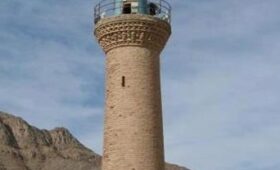Museum of ye Ebrat (Muzeh-ye Ebrat), Abarkuh: A Monument to Sacrifice
The Museum of ye Ebrat (Muzeh-ye Ebrat) in Abarkuh, located in the Yazd province of Iran, stands as a solemn tribute to the tragic martyrdom of the Hosseinian family, who were tragically executed by the Baha’i sect in 1929. The museum was established to honor the memory of this family, whose sacrifice is an important chapter in the town’s modern history, and to remind future generations of the consequences of blind fanaticism.
Historical Background
The museum was founded in 1982, marking the 53rd anniversary of the horrific event when the Hosseinian family was martyred by members of the Baha’i sect. The tragic event unfolded in Abarkuh in 1929, when a group of extremists attacked the family, killing them in a brutal act of violence. This incident became one of the darkest chapters in the history of the town, as it underscored the tensions between different religious factions during that time.
The Museum of ye Ebrat is dedicated to commemorating this family and preserving their memory. It was established as a historical site to not only honor the sacrifices made by the Hosseinians but also to educate the public about the devastating effects of religious intolerance.
Exhibits and Themes
The museum’s exhibits reflect the tragic event and the martyrdom of the Hosseinian family, and visitors are introduced to the story through a series of photos, documents, and personal belongings that belonged to the family. The display helps illuminate the suffering endured by the family, emphasizing the personal impact of the violence and illustrating the social climate that led to the tragic incident.
One of the key objectives of the museum is to raise awareness about the importance of unity, peace, and tolerance among different religious and social groups. The museum’s message is clear: it urges visitors to reflect on the importance of overcoming divisions, ensuring that such tragic events are never repeated in the future.
Architecture and Layout
The museum is housed in an old traditional building that reflects the architecture typical of Abarkuh and the Yazd province. It is designed with a blend of Islamic and Persian traditional architectural elements, featuring domed roofs, vaulted ceilings, and elegant arches that give the space a timeless feel. The layout of the museum is simple yet impactful, with carefully placed displays designed to immerse visitors in the narrative of the Hosseinian family.
In addition to photographs and written accounts of the incident, the museum also features interactive displays where visitors can learn about the historical and religious context that surrounded the tragedy. The space is both a place of reflection and an educational tool.
Cultural and Educational Importance
The Museum of ye Ebrat serves an educational purpose beyond just honoring the martyrdom of the Hosseinian family. It is a place where visitors can learn about religious tolerance, human rights, and the dangers of extremism. The museum encourages reflection on how religious differences should not result in violence, and it emphasizes the importance of peaceful coexistence and mutual respect among different communities.
Moreover, the museum highlights the significant impact that historical events can have on local culture and identity, contributing to the collective memory of the people of Abarkuh. Visitors come not only to learn about the tragic incident but also to understand the lessons it holds for contemporary society.
The Museum of ye Ebrat in Abarkuh is a monument to sacrifice and a reminder of the cost of intolerance. It stands as a testament to the Hosseinian family’s bravery and sacrifice, while promoting unity, tolerance, and understanding in society. Through its exhibits, the museum educates future generations on the importance of peaceful coexistence and the devastating consequences of religious extremism. The Museum of ye Ebratis not only a historical site but also a place where the lessons of the past are cherished and shared with visitors from around the world.




